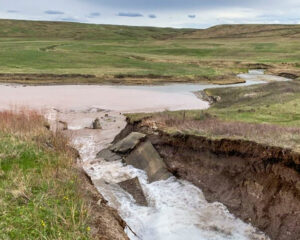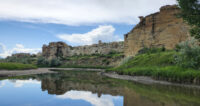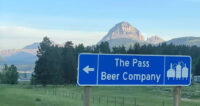Milk River water issues continue after structure failure
By Jensen, Randy on August 4, 2020.
 United States Bureau of Reclamation photo -
The last of five drop structures that move water through the St. Mary Canal to the North Fork of the Milk River is seen before and after its failure earlier this year northwest of Cutbank, Montana.
United States Bureau of Reclamation photo -
The last of five drop structures that move water through the St. Mary Canal to the North Fork of the Milk River is seen before and after its failure earlier this year northwest of Cutbank, Montana.Tim Kalinowski
Lethbridge Herald
tkalinowski@lethbridgeherald.com
Work continues on the replacement of the failed Drop 5 and failing Drop 2 structures on the St. Mary River diversion canal in Montana.
When the Drop 5 structure near Whiskey Gap failed in May, it cut off all St. Mary River diversion water moving through the Canadian side of the Milk River, which has since been reduced to natural flow only. This significantly impacted irrigators on this side of the border who rely on that supply, and brought additional challenges to the drinking water capacity of the Town of Milk River and Village of Coutts.
According to the U.S. Bureau of Reclamation Montana office, construction crews have been on site and working since June 16 to safely remove the old structures and are beginning to formulate their replacements.
“Construction crews arrived on site June 16 and initiated efforts to remove both structures,” confirms Steve Davies, Montana Area Manager for the U.S. Bureau of Reclamation in a statement released to The Herald on Friday. “Construction schedules, if not impacted by weather or COVID-19 setbacks, are expected to be completed sometime this fall.
“Depending on the actual completion date and weather conditions, Reclamation plans to resume St. Mary Canal operations to move some water to Fresno Reservoir to help replenish the depleted water supply and help provide additional carry-over storage for next year.”
Davies goes on to state as part of ongoing water conservation efforts, irrigation deliveries for Milk River Project water users and other junior water rights holders are being discontinued as of this week.
He also confirms municipal water deliveries to 14,000 users, primarily in Havre, Chinook and Harlem, Mont., are not affected by the failure of the Drop 5 structure, and water reserves should remain in decent shape through the fall and winter period after all irrigation is discontinued.
Davies acknowledges the ongoing difficulties communities and irrigators on both sides of the border face as the construction work continues.
“The water supply shortage is difficult for everyone in the Milk River Basin both in the United States and Canada,” he says. “Permanent repairs to the St. Mary Canal drop structures are currently underway in support of a more reliable future water supply. The repairs, along with diligent water management, should lead to improved water supplies in the coming year.”
Follow @TimKalHerald on Twitter
14-13




